14 miles through Paris, 2018
I don’t remember exactly when I first heard about the Pari Roller — the Friday night skate in Paris. It was sometime in the late 1990s, back when inline skating was going strong everywhere. I remember reading that the crowds would reach as high as 35,000 on summer skates, an absolutely astonishing crowd. As a lover of cities and a fan of skating, I was immediately captivated and knew I wanted to participate — someday.
We were living in San Francisco at that time and discovered that SF also had a Friday night skate (FNS), albeit only dozens strong, not tens of thousands. While the SF skate was more geographically accessible, it was far more topographically challenging — and my skating skills were definitely not up to it. I was skating in Golden Gate Park on Sundays, but not enough to get good, and so my desire to do the FNS (let alone the Pari Roller) remained just a dream.
Fast forward a dozen years. While traveling to Paris regularly for work, I happened upon the Sunday skate while walking around the city. It didn’t have the same city-at-night allure as the Pari Roller, but it seemed more accessible. With my skating skills now even more atrophied, I filed away the idea of doing the Sunday skate, again in the Someday folder.
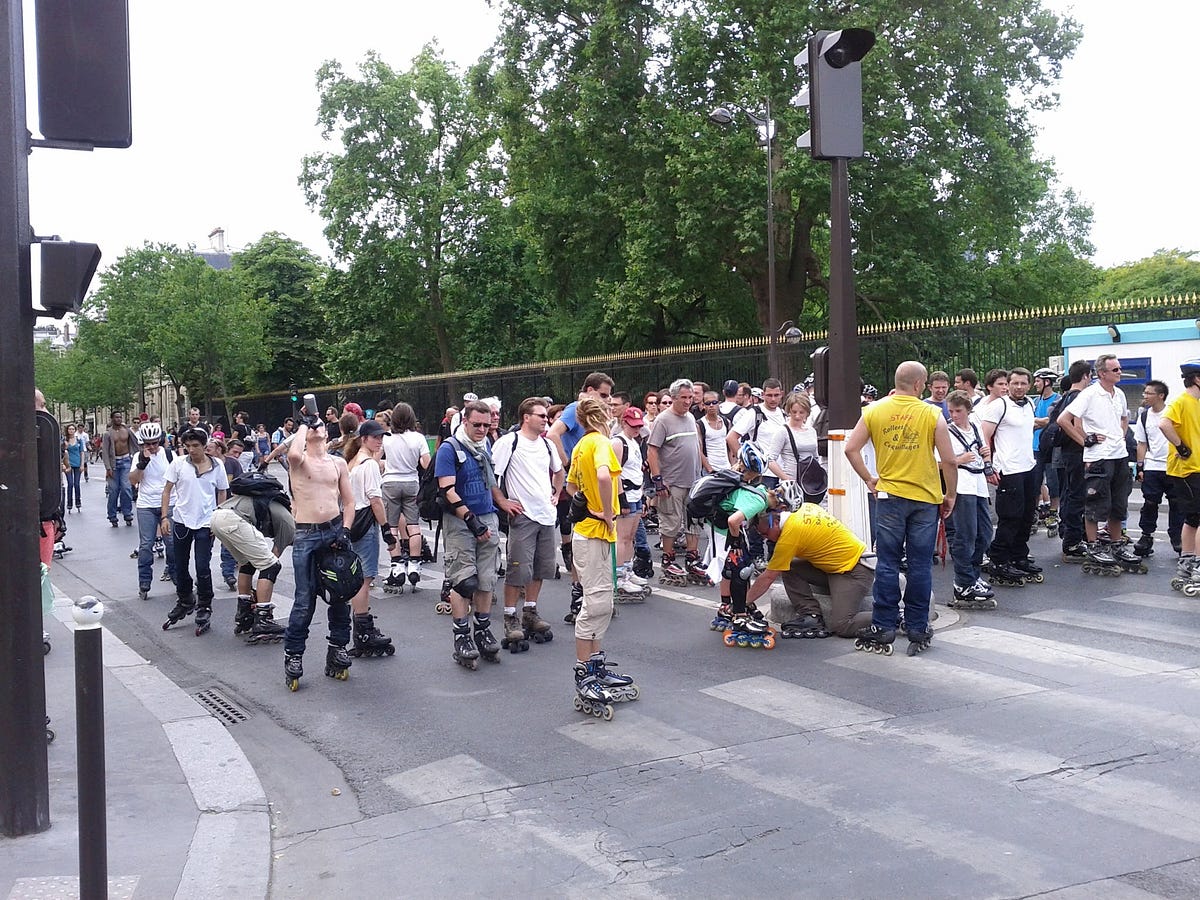
It’s hard to say no to kids, though. When we decided to take a family trip to Paris this year, the kids (10 and 12) immediately suggested we all do the Pari Roller. Ridiculous, I said — none of us were nearly good enough skaters, and it didn’t seem kid friendly. Let’s do the Sunday skate then! they countered. That seemed only slightly less ridiculous, but they kept suggesting it, and I kept mulling it over until it became a foregone conclusion. (My amazing wife, who already had decent skating skills and who is athletically gifted, was game for anything — her default state.)
And so, preparation began. While all the information is out there, I didn’t find a comprehensive resource or first-hand narrative for tourists doing the skate, which is why I’m writing this.
The Basics
First thing to know: the Sunday skate is put on by a group called Rollers & Coquillages. The route changes weekly and is typically around 20km (~13 miles). They post a map of the course every week, about a day before the event, once the route has been finalized with the police (who support the ride).
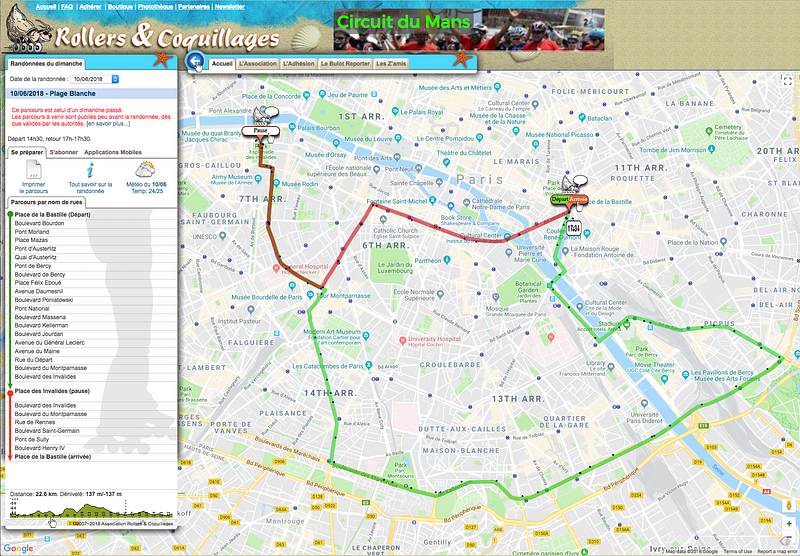
The number of participants has diminished since the late 90s, but still numbers in the thousands weekly. You can get a bit of a feel for the ride by looking at photos on the R&C site, or by watching YouTube videos. We found it fun to watch videos as a family, which built up excitement for the event in all of us.
The skate starts and ends in the same location every week — Place de la Bastille, which has good Metro access (1, 5, and 8 lines) — and always at the same time, 14:30. End time varies, but is somewhere around 17:00–17:30, with an “intermission” somewhere along the way. At a distance of 20km, this gives a pace of something like 8 km/h (5 mph) — so slow, if you’re a decent skater (I’m not!). There’s a wide range of skating ability among participants, ranging from extremely good to beginner.
Physical Prep
To get our (read: my) skating skills in shape for the ride, we decided to find a skating coach to work with. This proved harder than expected — internet searches didn’t yield much — but asking in a local skate shop lead us to Anna Zuver, who was an amazing find. If you’re not totally comfortable with your skating skills, I’d highly recommend finding and working with a good skate instructor.
Paris isn’t particularly hilly (Montmarte excepted), but the routes do vary in elevation. Being decent at stopping quickly is a must, particularly since you’re skating in a big crowd. One drill that Anna did with us that I found particularly helpful: going down a moderate hill individually, she would say when to start braking, and we would have to stop before a certain marker.
Control is equally important. Your fellow skaters will vary in ability and therefore predictability, and so you need to be reasonably confident handling these situations. Since the skate also takes place entirely in the street, not on any kind of path, there will be grates, potholes, manhole covers, etc that you’ll need to watch for and avoid. (More on this later.)
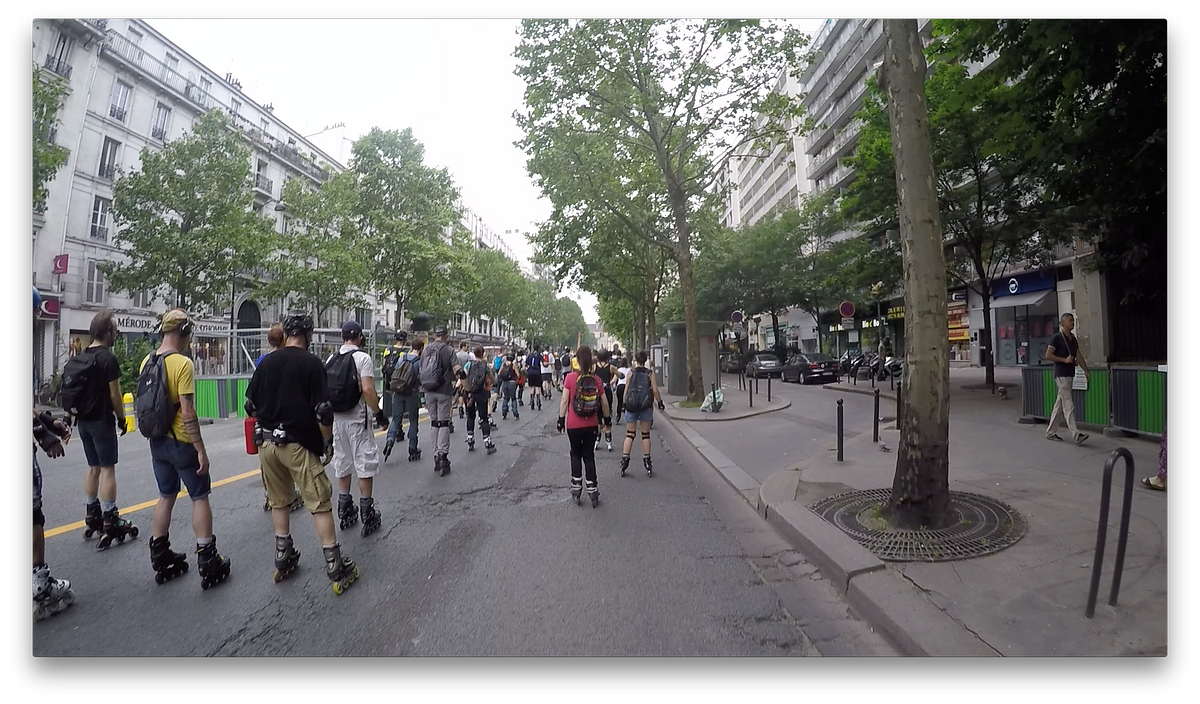
Endurance is another aspect to train for. 13 miles on city streets in surprisingly taxing if you’re not used to it, even at 5 mph. The longest I had skated prior to the Sunday skate was around 7 miles, which frankly was not enough.
Related to endurance: consider what is going to bother you at that distance. Fortunately (so to speak) on my 5+ mile skates, I developed blisters on the inside of my left ankle from over pronation. So when it came for the Sunday skate, I put some silicone bandaids in the affected places and wore two pairs of skate socks to minimize friction, leaving my feet feeling pretty fresh at the end of the skate. I doubt I would have made it the whole way if I hadn’t prepared for blisters.
The Gear
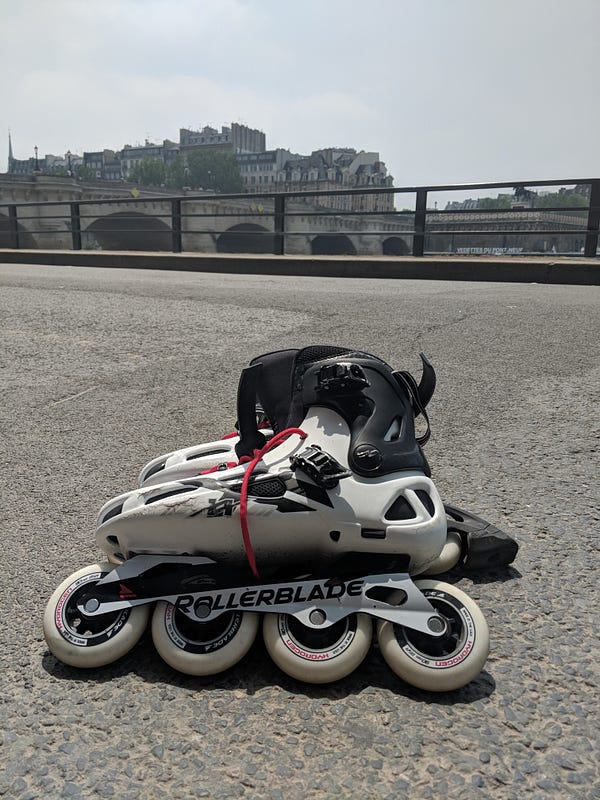
I dusted off my decent but ancient (circa early 2000s) Rollerblades with 80mm wheels when I started prepping for the Sunday skate. After using them for a couple of weeks, and thinking more about the rough Parisian streets, I decided to upgrade to newer skates and larger wheels. In a moment of perfect timing, Roll ATL had just opened, and I picked up Rollerblade Maxxum 90s (which, to be honest, are too much skate for me, but they inspire me to skate more). I felt that whatever I might lose in maneuverability with the larger wheels, I would more than gain in comfort and speed, and that did hold true on the Sunday skate. These new skates were a great decision.
For pads, I continued to use my old ones: Rollerblade aggressive knee and elbow pads, plus Harbinger wrist guards. Not that I’m doing any skating that would warrant such serious protection; I’m just clumsy. We had intended to all wear elbow pads as well, fearing a bad fall en route. But we found elbow pads add significantly to body heat and decided to forego them at the last minute.
For socks, Roll ATL hooked me up with some Rollerblade high performance socks. They’re comfortable and keep your feet cool.
I had an old Transpack skate bag that I continued to use with the new skates. It’s roomy for all your gear, but it turned out to be extraordinarily hot and heavy on my back along the route. During training I didn’t need to haul all my gear on my back, but in Paris, I needed to pack it for the Metro ride to the start — plus I wanted to make sure I had everything I could need along the route, especially if I decided to bail early. Aside from skates and pads, this included water, spare brakes, a tri-tool, wallet, phone, and extra metro tickets.
We also borrowed a GoPro Hero4 from a friend and strapped it onto our 10 year old’s helmet (a Triple8 Brainsaver). The GoPro’s head strap is lined with sticky rubber which held it nicely in place on the helmet, despite all the bumps and jumps.
Pre-Sunday Prep
We were fortunate to arrive in Paris on Thursday, allowing us ample time to adjust to the time zone. (On Friday evening we took the Metro to Montparnasse to watch the start of the Friday night skate just for fun — based on the level of the skaters we saw, it was a good call not to join them on this trip.)
On Saturday I ended up doing two practice skates — a ~6 mile skate along the quai on rive droite in the morning, and a ~5 mile skate with the family a bit through streets of Saint-Germain-des-Prés, then Île de la Cité, and back down to the quai. Île de la Cité was a terrible destination, where we were forced to choose between cobblestones or hoarding mass of tourists at Notre Dame. Sometimes we didn’t even have the choice and just got both. Still, after we survived it, we were proud of our coping skills and felt that much more confident for Sunday.
The quai along rive droite, however, is wonderful for skating. It’s wide, mostly smooth, very flat, and filled with other skaters, bikers, scooters, pedestrians, etc who are good warm up for the Sunday skate. If you’re staying anywhere close, I’d highly recommend it for practice.
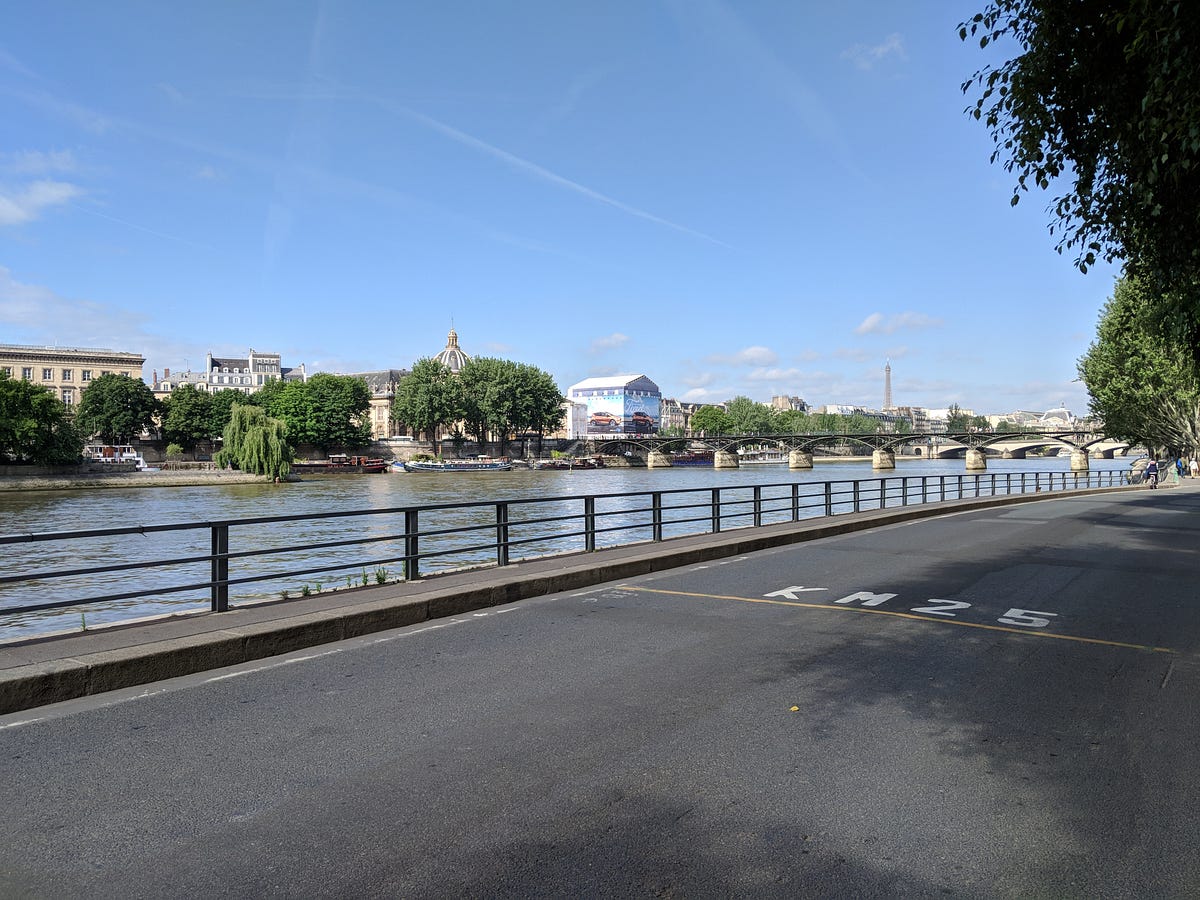
Some basic phrases
My French is très très pathétique, but here are a few phrases that I found helpful to keep in mind for the skate:
à ta gauche!/à ta droite! — on your left/right! Handy if you’re passing close to someone
attention! — watch out! (like, I’m about to crash into you)
désolé — sorry! (like, that I crashed into you)
Allez! — Go!
Allez! Allez! Allez! — Why the hell are you so slow?! Get going!
fait attention — look out (like, Hey, pothole up here)
The thing I quickly discovered is that, if your French is already not good under normal circumstances, prepare for it to be even worse when you’re exhausted and strained on a long ride. I had a hard time understanding and communicating with the excellent R&C staff while plodding up hills 11 miles in.
Traveling with Skates
We could have opted to rent skates in Paris: Nomadeshop, which is in Bastille where the Sunday skate begins, rents skates and is open before the skate. They were doing a brisk business the day we were there which is wonderful to see. But with four of us skating, the probability that all of us would be able to rent the right size and feel good in rental skates seemed too low for my taste, and we decided to pack our own.
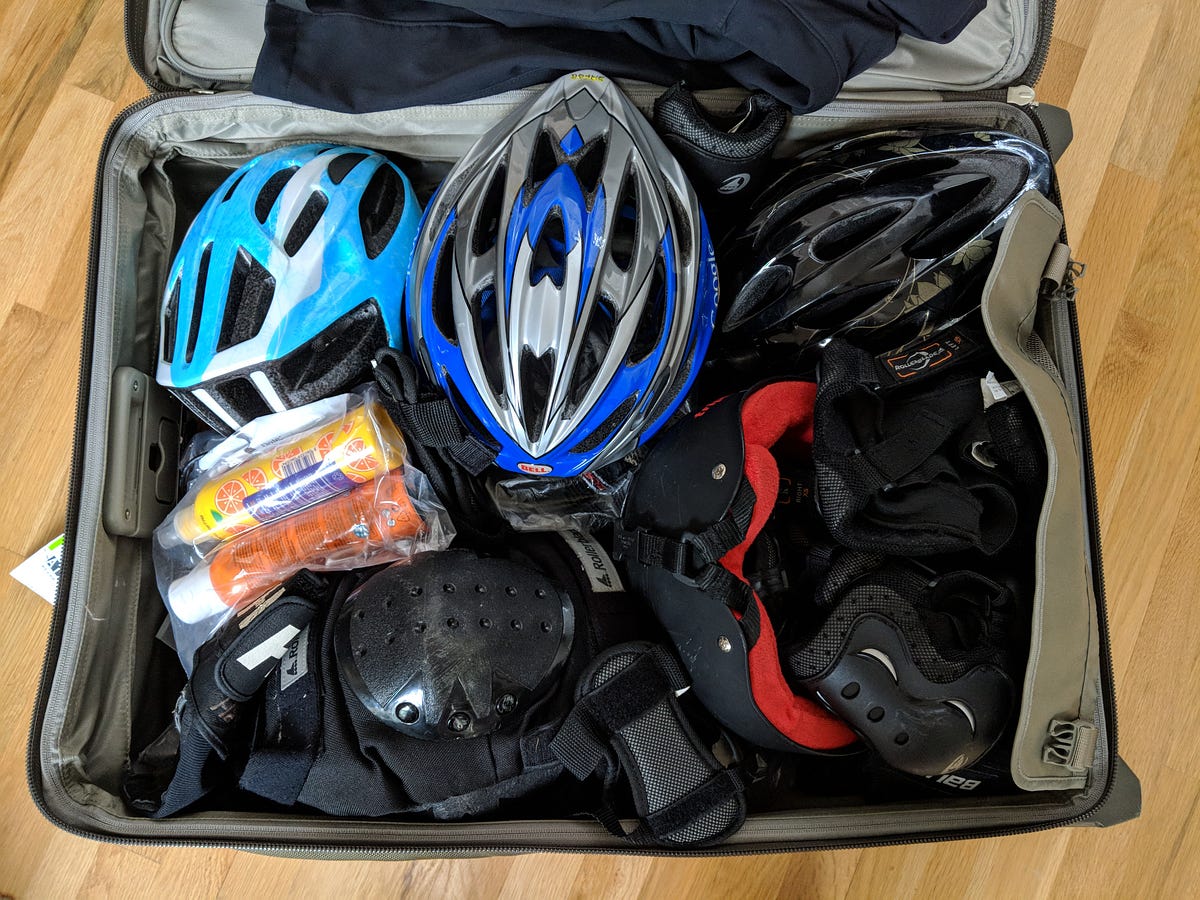
Instead of using the Transpacks as baggage, we opted to pack our skates in all in a large suitcase, along with pads and backpacks. In the Transpacks, the skates felt too exposed. In the suitcase we could pad them a bit more. In a moderately large suitcase, we were able to pack two pairs of skates, plus two Transpacks, four helmets, and four sets of pads. The kids each packed their skates in their regular roll aboard suitcases — benefits of having smaller skates!
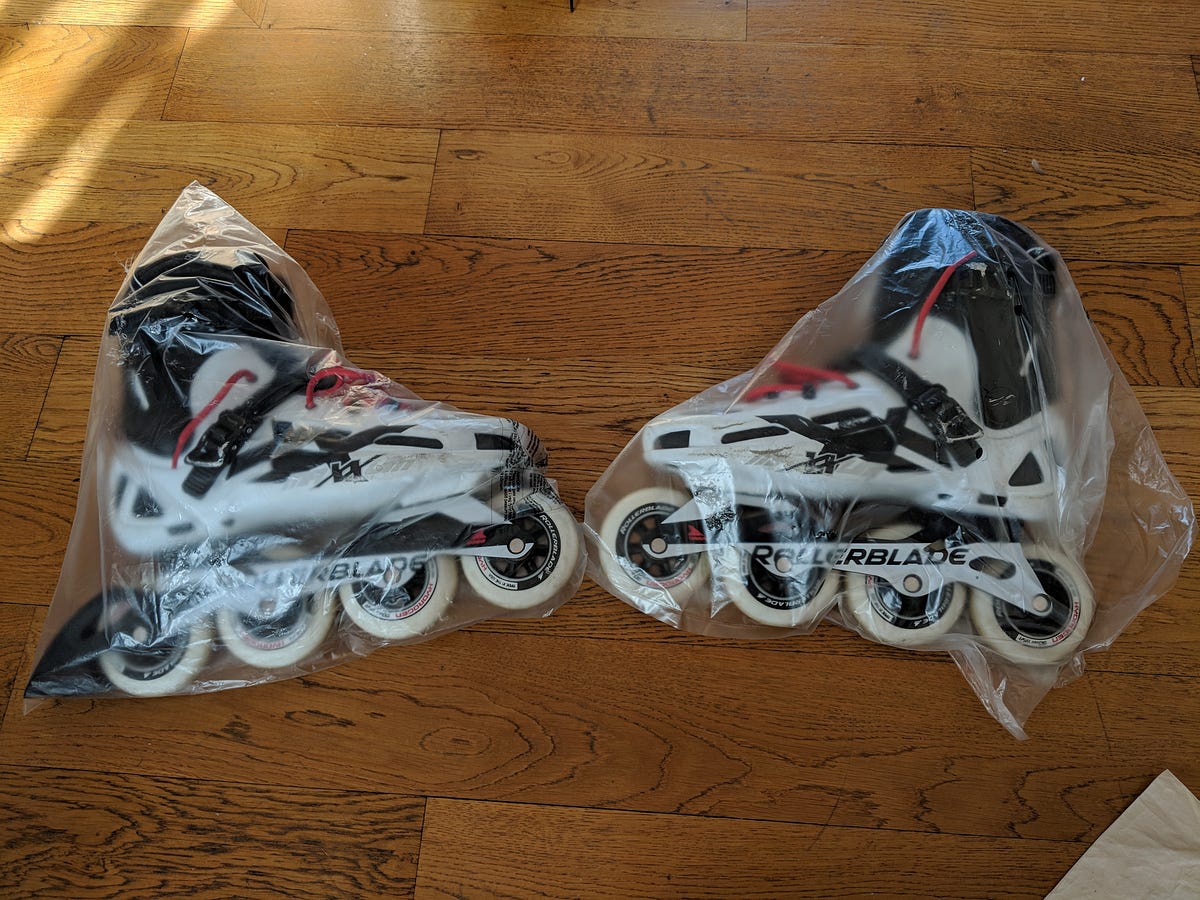
The actual experience
First, here’s some data for context:

The skate leaves Bastille at 14:30, so we took the Metro and planned to arrive before 14:00. As we were exiting the station we were fortunate to follow another skater (who was carrying his skates), showing us that Sortie 6 is the proper exit for Nomadeshop. There outside the shop, we found a mix of regulars warming up and a set of people renting skates. We similarly geared up and started stretching our legs.
The crowd was a mix of ages, spanning from around 9 years old to over 70 (and those folks were rockin’), and about an even split of men and women. I saw all varieties of skates: recreational, aggressive, speed skates, quads, you name it. You could pick out many of the regulars by their stylish clothes: skinny jeans, skirts, long sleeves shirts despite the heat, and even one woman in a white and black dress. I had a hard time estimating crowd size, but it was somewhere over a thousand.
At a minute before 14:30, a whistle went off to rally the skaters. I stepped off the curb into a rough gutter and…immediately fell. Derp. With that first carcass toss out of the way, I got up and started off, a little less jittery now.
The first few blocks were glorious and packed with riders on a wide, smooth street. Shortly thereafter we encountered a roundabout of cobblestone, and I panicked, trudging slowly and clumsily over the stones until one of the very kind R&C staff literally grabbed me (and some woman) by the hand and towed us close to the edge of the cobblestones, and which point he flung us forward, back onto smooth pavement. I was too amused and grateful to be embarrassed.
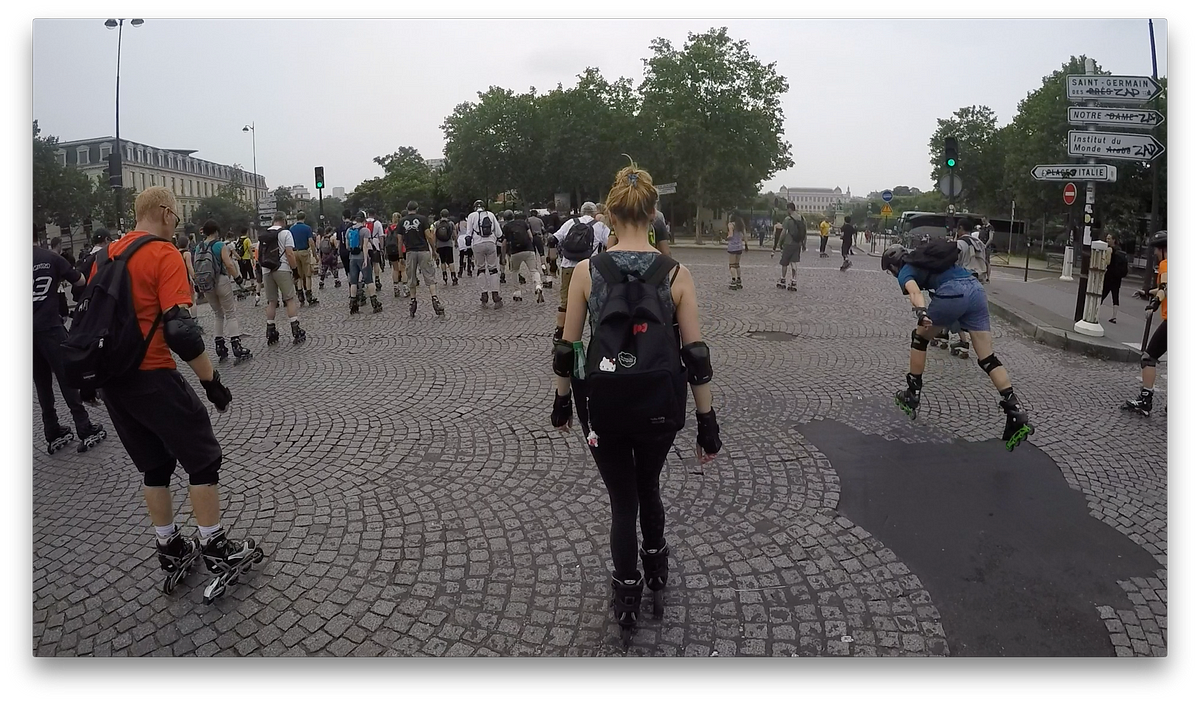
It was at that point that I realized the tactical error in our start. I thought Nomadeshop was at the start of the pack when the whistle went off, but really it was at the rear. So now I was close to the very end of the pack. This wasn’t a big problem, but both for safety and because they have a schedule to keep, the R&C folks keep the skating mass quite dense. This means that there are staff, ambulance, and police riding behind you pushing you to Allez! which was a bit intimidating at moments (particularly when it started drizzling and we were skating over several railroad tracks in the street). I’d ended up skating in the back 20% of the pack the entire ride.
To keep the density, the staffers stop the mass at various intersections until everyone is together again. (The side streets are corked by staffers to keep cars, bikers, and pedestrians at bay until the mass passes.) These short pauses are helpful for catching up to other skaters you might be with and for grabbing a quick sip of water. This allowed my wife and I to catch up with the kids who spent much of the first half of the ride way ahead in the group.
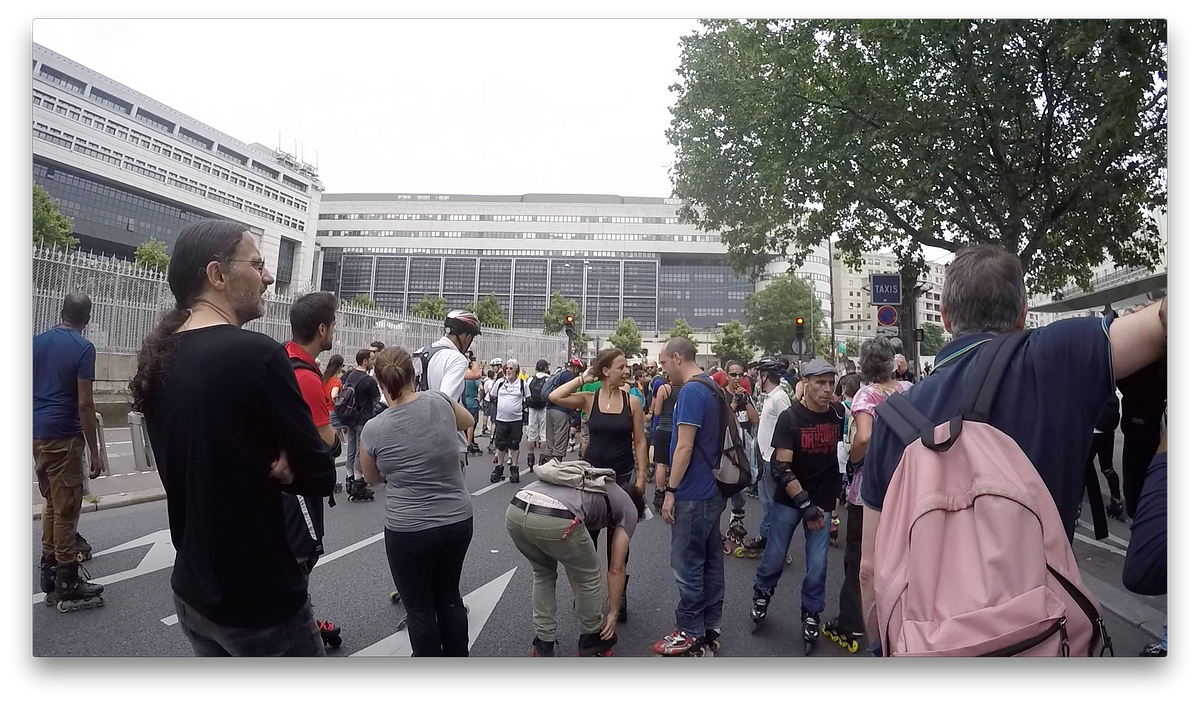
Despite riding on many busy streets, skating in traffic was never scary — the staff did a fantastic job corking, and drivers seemed to know and expect the skaters. Even riding against oncoming traffic felt safe, given our numbers.
The route turned out to be hillier than expected from viewing the course map, featuring several short-to-medium to somewhat steep climbs. On the third such climb, I saw my son struggling a bit near the gutter, so I skated up behind him. He turned out to be fine, but I stumbled and fell on some concrete drippings on the street (going uphill! come on!) — these street turds were everywhere along some blocks. Two friendly staffers came over and started giving him a lot of instructions in very rapid French, and I completely failed to understand them. Nevertheless, one of them got behind me and starting pushing me uphill so I could gain momentum and get back to skating — no easy task for him I’m sure, but I was deeply grateful.
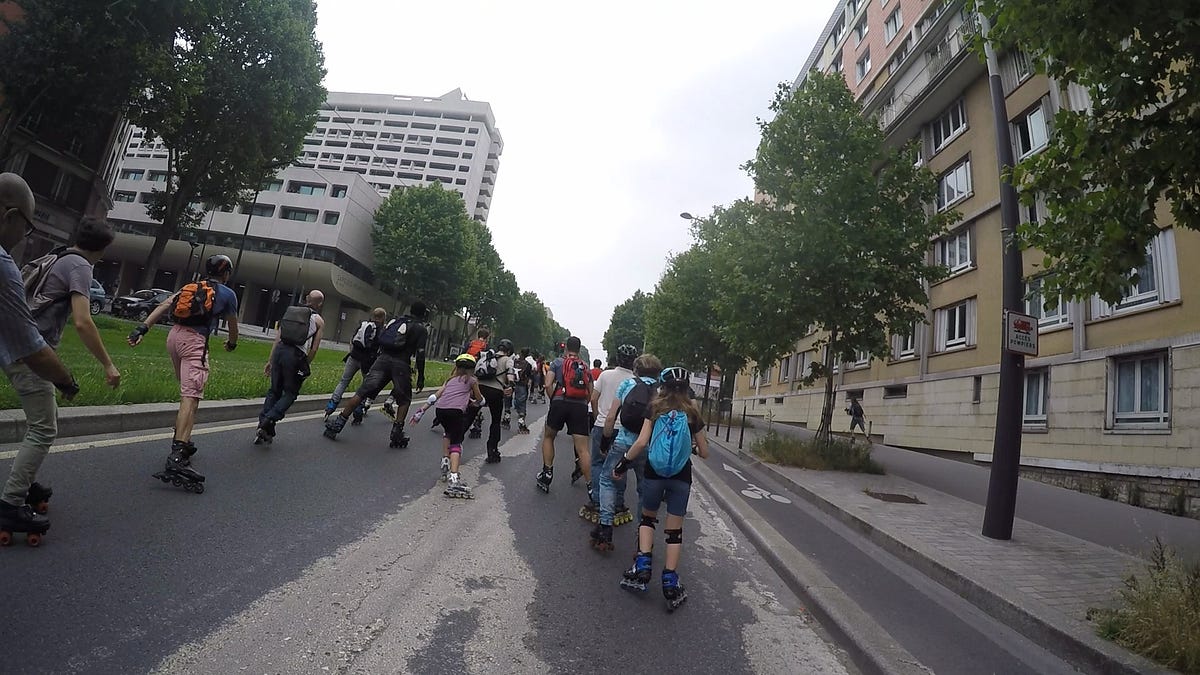
The route wasn’t just uphill though; it was rolling as you can see from the elevation graph above. Although it was braking downhill in crowds that I had feared this most, this turned out to be one of the easier and most pleasant parts. While I normally get a bit nervous bombing a hill by myself, being with a crowd moving at close to the same speed was calming since it felt like we were all moving slowly. Thanks, relativity!
As we headed down to Tour Montparnasse, a regular rider warned us that the roads would be getting rougher (but flatter, at least). Indeed, they did. On Blvd Montparnasse everyone in our party felt like our feet were going numb on the bumpy road. It was the distance and consistency of the rough surface, plus our speed, that did us in, rather than the size of the bumps. After surviving that stretch, we glided down a nice hill into the Esplinade des Invalides where we had our scheduled break (or “intermission”, as R&C delightfully calls it).
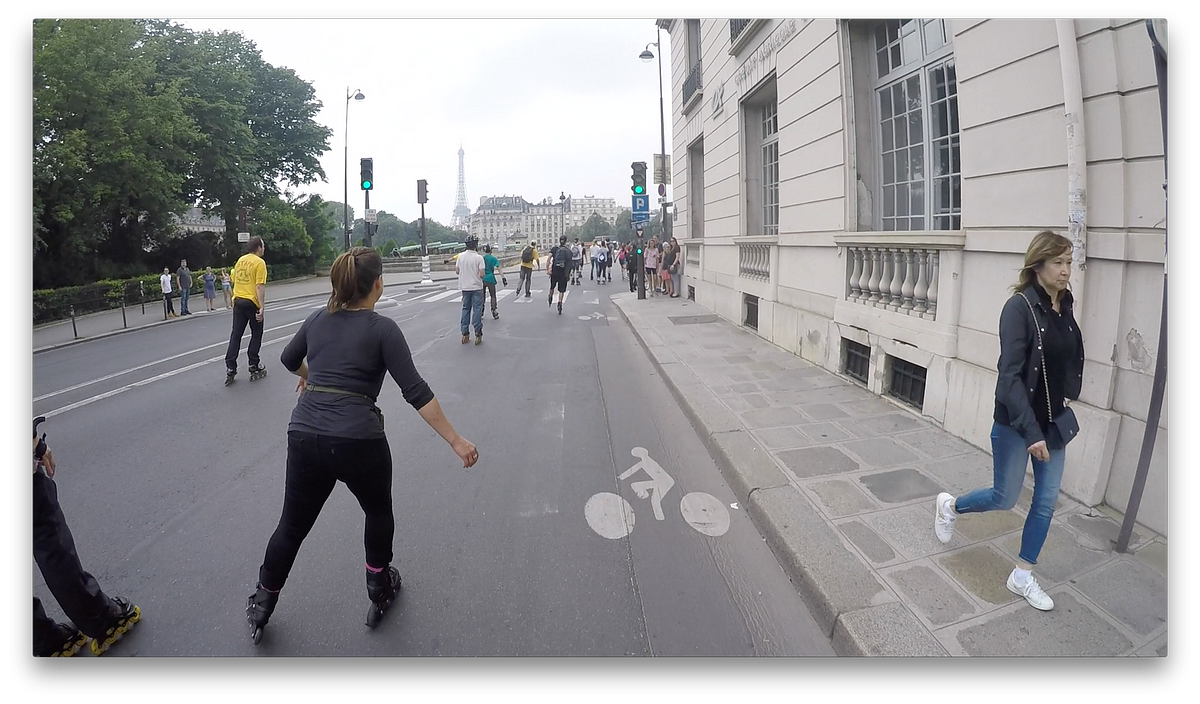
We’d now completed 10.25 miles — just under 4 miles left to go. My son had been complaining about a toenail problem for the previous few miles, so he and my wife decided to stop at Invalides (the irony!) while my daughter and I pushed back towards Bastille. I expected to find street vendors selling bottles of water at the intermission point, but was surprised when I saw none. (Note to aspiring entrepreneurs! You could make money hand over fist selling water to people like me.)

The regular rider mentioned above had also warned us that after intermission, many of the less skilled riders drop off so there’s even more pressure to keep with the rest of the pack and not fall off the back. This proved to be true; just guessing, but probably half the group stopped at the intermission point.
Keeping up the pace on Rue de Rennes required a lot of energy and willpower. By the time we made it to the Fontaine Saint-Michel, however, we were feeling better and slightly more energetic. Once we crossed over Île Saint-Louis the end was literally in sight — the towering statue at Bastille. Sure, it was still two miles away, but seeing it ahead of us we knew we’d made it.
Skating back into Bastille, there was little fanfare and the mood was subdued, but a few of us clapped and whooped. As my daughter and I (mostly I) dropped exhaustedly to the curb to strip our gear, I noticed many of the skaters looked as fresh as the moment we’d started. Oh, to be that good one day!

We both were hungry, thirsty, and tired. Surprisingly the cafe next to Sortie 6 (L’Arsenal Bastille) was only moderately busy, not overflowing with skaters as I’d imagined it might be. I tried to convince my daughter to get some frites and lemonade so I could sip a rosé in victory, but alas, she just wanted to hop on the Metro and head home, so my rosé had to wait. Next time.
And here I just have to give extra props to my daughter who managed to do the entire skate on very basic 72mm skates with a missing brake pad (long story). She was simply inspiration on wheels.
GoPro HiLight
Here’s a short video of the skate.
What I would do differently next time
All in all, our preparation served us very well and I would only tweak a few things:
- Use a smaller pack: I thought I was being smart with the Transpack, but it was just too heavy and too hot. Next time I’d use a small, regular backpack for water, pads, keys, etc, and carry my skates by hand. I’d also ditch the extra brakes and tools, and rely on staffers for any assistance.
- More endurance and hill prep: While I think most of our exhaustion was from first-time nerves, I definitely wasn’t as ready for the distance and bursty hills as I’d like to be. This is easy to train for anywhere.
- Don’t just carry water: We each had a bottle water, but some electrolytes along the way would have helped. Had the skate been a few miles longer I think we would have bonked.
- Cobblestones: The hardest and most unique challenge (as an American) were the cobblestones. I knew this going in, and had practiced riding on some bumpy bricks in a nearby parking lot, but it was woefully unsatisfactory preparation for irregular, smooth, rounded-topped stones. I think the only preparation for cobblestone is cobblestone, so try to seek some out in training. Or, at least ride on some in Paris before the Sunday skate to get a feel for them.
- Small kneepads: The aggressive kneepads I used were just too hot along the ride and weighed me down. Switching to lighter recreational pads wouldn’t have sacrificed safety and would have been more comfortable. I would continue to use my Harbinger gloves which have better wrist protection than most.
- Improve my French: It’s hard to follow directions when you can’t understand them, and all of the announcements along the skate are in French of course. Prepare for your French language skills to be cut in half while exerting yourself physically.
Can’t wait to put these refinements in action on my next Sunday skate. Which can’t come soon enough for my taste.